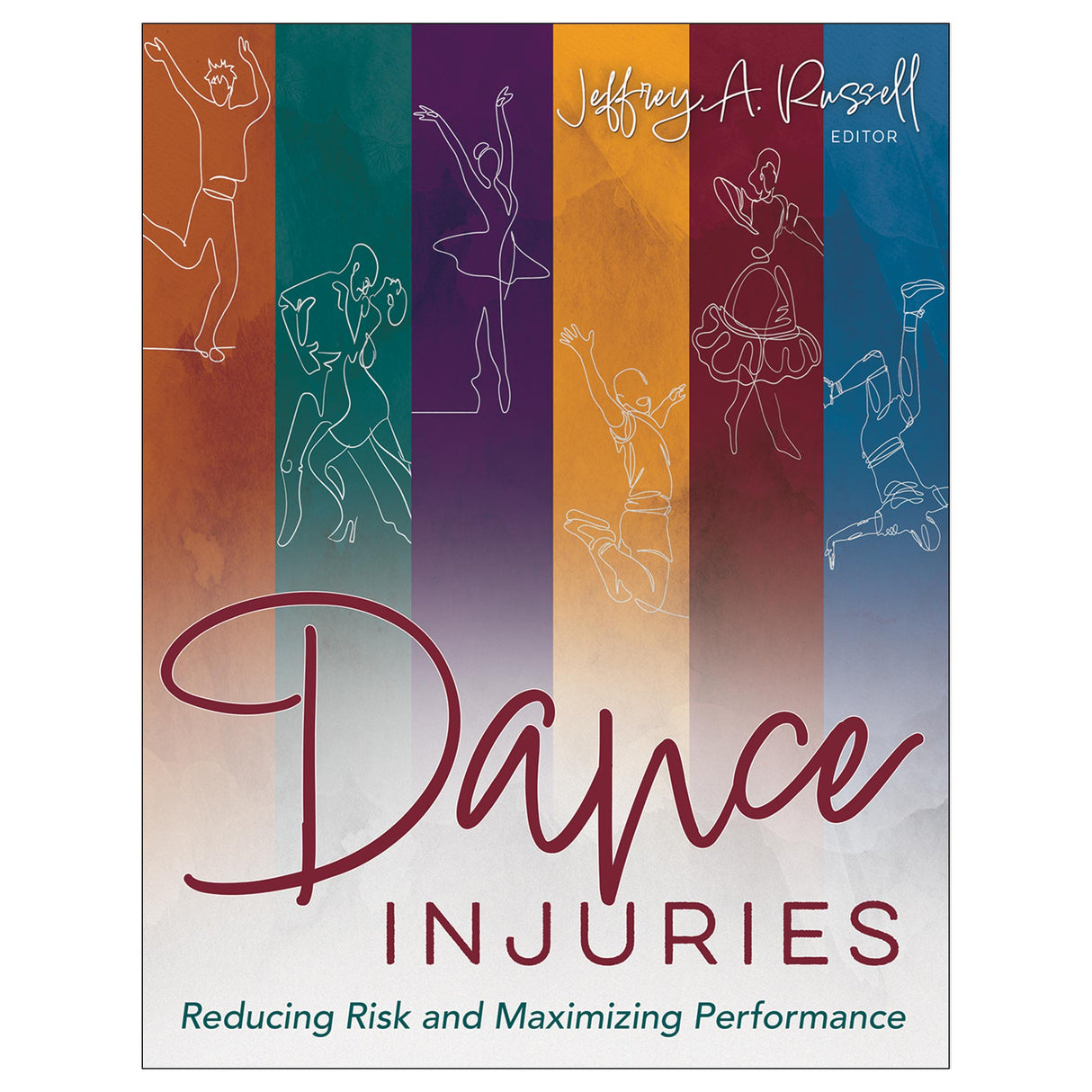Dance Injuries Ebook With HKPropel Access
Reducing Risk and Maximizing Performance
Author: Jeffrey A. Russell
$94.00 USD

Written by an international team of experts in the dance medicine and science field, including physicians, athletic trainers, physical therapists, researchers, and dance educators, Dance Injuries provides an overview of common dance injuries across a wide variety of dance styles. From their extensive work with dancers, the authors provide valuable insight into minimizing dance injuries to maximize dancer longevity.
The text offers practical ways to reduce the risk of dance injuries. Conditioning, flexibility training, nutrition, hydration, recovery, and rest are addressed. Additionally, a chapter on holistic wellness helps dancers apply a wellness mindset to their training and performance.
Dance Injuries is richly illustrated with nearly 200 full-color illustrations and 150 photos to help dancers connect with the essential information the book offers. Armed with the understanding gained from the book’s medical diagrams, dancers will be motivated to adopt habits to reduce the likelihood of an injury.
To further augment learning, the text presents
- strategies for accessing and interpreting scientific research on dance injuries;
- approaches to working with various health care professionals when an injury occurs;
- recurring special elements, sidebars, key terms, and discussion questions; and
- resources offered online through HKPropel, including application activities, supplemental information, and coverage of niche topics connected to chapter content.
Dance Injuries includes vital information to properly train dancers technically, physically, mentally to reduce dancers’ risk of injury and allow them to perform their best in dance classes, rehearsals, and performances.
Note: A code for accessing HKPropel is included with this ebook.
Audience
Upper-level students in dance programs at universities, colleges, junior and community colleges, and conservatories.Ruth Solomon, Professor Emerita
John Solomon, PhD
Preface
Jeffrey A. Russell, PhD, ATC
Part I. Setting the Stage for Reducing Injuries
Chapter 1. Introduction to Injury Risk Reduction and Performance
Caroline Bolling, PT, PhD
Robin Kish, MS, MFA
Jeffrey A. Russell, PhD, ATC
Health and Wellness
Holistic Wellness
Applying the Holistic Wellness Model
Intrinsic and Extrinsic Motivation
University Dance Training
Wellness Mindset
Dance Injuries
Risk Factors and Reducing Injury Risk
Conclusions and Practical Relevance
Discussion Questions
Chapter 2. Injuries Across Dance Genres
Róisín Cahalan, PhD
Kelli Sharp, DPT
Rose Schmieg, DHSc, PT, ATC
What Is Injury?
Injury and Pain
Injury Risk Factors
Mechanisms of Injury
Injuries in Different Dance Genres
Conclusions and Practical Relevance
Discussion Questions
Chapter 3. Using Scientific Research to Reduce Injury Risk and Maximize Performance
Danielle N. Jarvis, PhD, ATC
Sheyi Ojofeitimi, PT, DPT, OCS, CFMT
Jatin Ambegaonkar, PhD, ATC, OT, CSCS, FIADMS
The Scientific Method
Typical Sections in a Primary Source Research Article
Research Resources
Types of Research Literature
Approaches to Research
Accessing Research
Performing Arts and Non–Performing Arts Sources
Reading Research to Evaluate Quality
Interpreting Statistical Information
Application of Research
Conclusions and Practical Relevance
Discussion Questions
Chapter 4. Physiology of Dance Training and Performance
Emma Redding, PhD, FIADMS
Sarah Needham-Beck, PhD
Cardiovascular System
Respiratory System
Muscle Physiology
Energy Systems
Physiological Demands of Dance
Adaptations to Training Cardiorespiratory Fitness
Testing Dancers’ Physical Capacities
Conclusions and Practical Relevance
Discussion Questions
Part II. Care Inside and Out
Chapter 5. Conditioning as an Injury Risk Reduction Measure
Elaine Winslow-Redmond, MS, ATC
Monica Lorenzo, MS, ATC
Diane Diefenderfer
Basic Principles of Training
Anaerobic Training for Dance
Aerobic Training for Dance
Strength Training for Dance
Building a Strength Training Program
Hormone Cycling and Training Programming
The Pilates Method
Myths About Conditioning for Dancers
Conclusions and Practical Relevance
Discussion Questions
Chapter 6. Flexibility Training for Injury Reduction and Performance
Desiree A. Unsworth, PT, DPT
Merry Lynn Morris, PhD, MFA, LMT
Gary Galbraith, MFA
Introduction to Flexibility
Tissues Involved in Flexibility
Biomechanical Properties of Tissues Impacting Flexibility
Spinal Cord Reflexes
Hypermobility
Types of Stretching
Risks of Stretching
Methods for Flexibility Training
Conclusions and Practical Relevance
Discussion Questions
Chapter 7. Nutrition, Hydration, Rest, and Recovery
Ann F. Brown, PhD, CISSN, FIADMS
Meghan A. Brown, PhD, FHEA, SENR
Jasmine D. Challis, RD, MRes
Relationship of Proper Nutrition to Whole-Person Wellness
Macronutrients
Micronutrients
Hydration, Sweat Loss, and Fluid Needs
Translating Nutrients Into Food: Reading Food Labels
Grocery Shopping Challenges
Basic Nutrition Recommendations for Highly Active Individuals
Considerations for Dietary Practices
Body Composition in Dance
Nutritional Strategies for Injury Prevention, Recovery, and Rehabilitation
Rest as a Necessary Component of Dance
Conclusions and Practical Relevance
Discussion Questions
Chapter 8. Psychological Wellness and Mental Health
Jo-Anne LaFlèche, MPsy, MA
Bonnie Robson, MD, FRCPC
Kathleen McGuire Gaines, BA
Mental Health Statistics and Injury
Aesthetic and Performance Ideals
Psychological Issues in Dance Practice
Unconstructive Life Habits
Common Mental Health Challenges
A Culture of Silence and Pain
Mental Health Tools and Self-Care Measures
Conclusions and Practical Relevance
Discussion Questions
Chapter 9. First Aid and Emergency Planning for the Studio and Stage
Kevin Brown, MEd, ATC
Melody Hrubes, MD
Laura Santos, MS, LAT, ATC
Role of Health and Safety in Dance Training and Performance
Responsibility for Health and Safety
How to Manage Emergencies as an Immediate Responder
First Aid Knowledge for the University Dancer
Emergency Action Planning
Emergency Equipment
Recommended Training for Dancers and Teachers
Emergency Planning and Response in the Context of Whole-Person Wellness
Conclusions and Practical Relevance
Discussion Questions
Chapter 10. General Principles of Caring for Injuries
Selina Shah, MD, FACP
Jacqui Haas, MS, ATC Ret.
Debra Crookshanks, BSc, PT
Types of Injuries
Physiological Stages of Healing
Care of Soft Tissue Injuries
Healing Environment
Conclusions and Practical Relevance
Discussion Questions
Part III. Common Dance Injuries
Chapter 11. Dance Injuries in the Lower Extremity
Amanda Blackmon, PT, DPT, OCS, CMTPT
Nancy Kadel, MD
Meg Schneider, MS, ATC
Basic Anatomical Structure of the Lower Extremity
Anatomical Variations in the Lower Extremity
Injuries to the Lower Extremity
Other Common Conditions of the Feet
Dance Shoes and the Feet
Conclusions and Practical Relevance
Discussion Questions
Chapter 12. Dance Injuries in the Upper Extremity
Steven Karageanes, DO, FAOASM
Amanda Donahue, MS, ATC
Lynnette Khoo-Summers, PT, DPT
Basic Anatomical Structure of the Upper Extremity
Common Injuries in the Upper Extremity
Conclusions and Practical Relevance
Discussion Questions
Chapter 13. Dance Injuries in the Lumbar Spine, Pelvic Floor, and Hips
Lauren Elson, MD
Brooke Winder, DPT
Susan Mayes, PhD, AM
Bones and Joints of the Lumbar Spine
Lumbar Ligaments and Muscles
Mechanics and Function of the Lumbar Spine
Lumbar Dysfunction and Injury
Pelvic Floor Anatomy
Pelvic Floor Dysfunction and Injury
The Core and Pressure-Management System
Hip Anatomy
Hip Mechanics
Turnout
Hip Injuries in Dance
Conclusions and Practical Relevance
Discussion Questions
Chapter 14. Head Impacts, Whiplash Injuries, and Concussions in Dance
Lauren McIntyre, ATC
Kathleen Davenport, MD
Basic Anatomy and Function of the Head and Brain
Concussions
Concussion Mechanisms in Dance
Incidence of Concussion in Dance
Management of Concussion in Dance
Minimizing Risk of Concussion in Dance
Common Head Injuries Other Than Concussions
Conclusions and Practical Relevance
Discussion Questions
Part IV. Coordinated Safety and Wellness
Chapter 15. Working Effectively With Health Care Professionals
Tina Wang, MD
Carina Nasrallah, MS, ATC, LAT, CISSN, PAM-C
Gayanne Grossman, PT, EdM, BFA, FIADMS
Jeffrey A. Russell, PhD, ATC
Types of Health Care Providers
The Role of Professionals Not Licensed in Health Care
Knowing When to Pursue Professional Health Care Evaluation
Types of Health Care Delivery Settings
Tips for Successfully Navigating the Health Care System
Conclusions and Practical Relevance
Discussion Questions
Chapter 16. Navigating Risks and Implementing Best Practices for Success in Dance
Jennifer Deckert, MFA
Margaret Wilson, PhD
Jan Dunn, MS
Environmental Risks
Moral Safety
Emotional and Psychosocial Considerations
Navigating Your Identity Within the Dance Environment
Advocacy
How to Best Prepare Yourself for Success
Action Items for Students
Considerations for Educators
Conclusions and Practical Relevance
Discussion Questions
Appendix A. International Mental Health Resources
Jo-Anne La Flèche, MPsy, MA
Bonnie Robson, MD, FRCPC
Kathleen McGuire Gaines, BA
Appendix B. Psychological Safety in Dance: Emotions and Intimacy
Misty Lown, ME-PD
Courtney Abbott, MFA
Appendix C. Screening for Dancer Health
Laura Santos, MS, LAT, ATC
Appendix D. Disability Dance and Integrated Dance: Inviting a Radical Re-Visioning
Merry Lynn Morris, PhD, MFA
Appendix E. Considerations for Professional Dance
Sheyi Ojofeitimi, PT, DPT, OCS, CFMT
Kori L. Kirschner, MS, LAT, ATC, CSCS*D
Appendix F. Artistry and Athletics: The Rigors of College Dance Team
Olivia Placita, BS
Melissa McGhee, BS
Hydration, sweat loss, and fluid needs
Risk reduction versus injury prevention




All ancillaries are free to adopting instructors through HKPropel.
Test package. Contains questions in true-false, fill-in-the-blank, essay and short-answer, and multiple-choice formats. The files may be downloaded for integration with a learning management system or printed for use as paper-based tests. Instructors may also create their own customized quizzes or tests from the test bank questions to assign to students directly through HKPropel. Multiple-choice and true-false questions are automatically graded, and instructors can review student scores in the platform.
Presentation package. Features PowerPoint slides of text, artwork, and tables from the book that can be used for class discussion and presentation. The slides in the presentation package can be used directly within PowerPoint or printed to make handouts for students. Instructors can easily add, modify, and rearrange the order of the slides.
Instructors also receive access to all student materials in HKPropel. For Dance Injuries, this includes application activities, supplemental information, and coverage of niche topics connected to chapter content.





